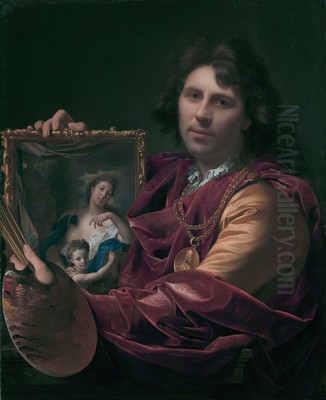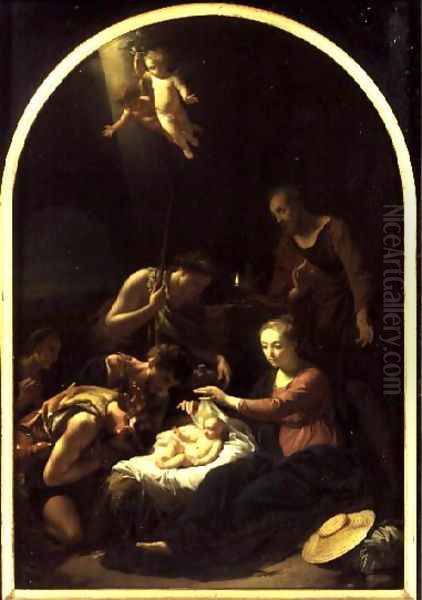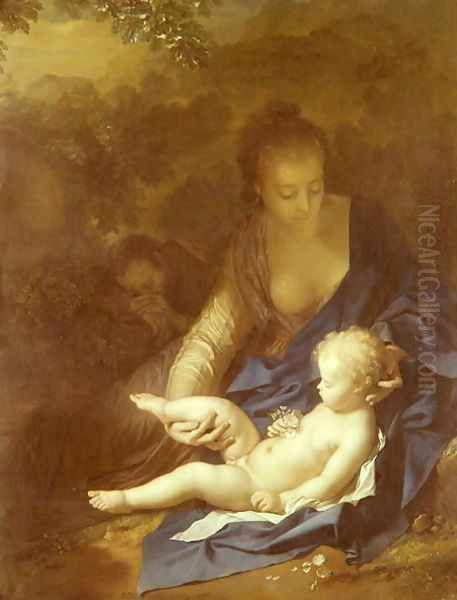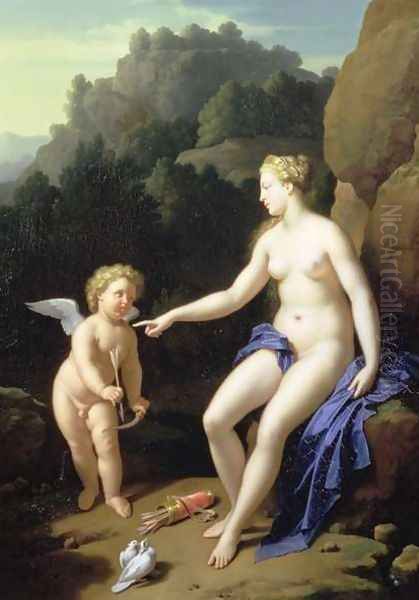
Adriaen van der Werff stands as a pivotal figure in the twilight of the Dutch Golden Age, an artist whose work embodies the transition towards the refined classicism favored by European courts in the late 17th and early 18th centuries. Born on January 21, 1659, in Kralingen, a village near the bustling port city of Rotterdam, and passing away on November 12, 1722, in Rotterdam itself, Van der Werff achieved immense fame and fortune during his lifetime, becoming one of the most sought-after painters in Europe. His meticulously crafted paintings, characterized by their smooth, enamel-like finish and elegant, idealized figures, marked a departure from the earthy realism often associated with earlier Dutch masters, aligning instead with international Baroque sensibilities.
His journey from a promising young talent in Rotterdam to a celebrated court painter encapsulates a fascinating chapter in art history, reflecting shifting tastes and the enduring appeal of classical ideals. Though his reputation waned in the centuries following his death, modern scholarship has rightfully restored Adriaen van der Werff to his place as a master technician and a key proponent of Dutch classicism, whose influence extended far beyond the borders of the Dutch Republic.
Early Life and Formative Years
Adriaen van der Werff hailed from a prosperous family belonging to the Remonstrant faith, a Protestant denomination that faced periods of persecution but was relatively established in the tolerant environment of Rotterdam. This city, a major center of trade and culture, provided a rich backdrop for the young artist's development, offering access to significant art collections and a thriving artistic community. His innate talent for drawing and painting became apparent at a remarkably young age.
Recognizing his potential, his family arranged for him to begin formal artistic training around the age of ten. This early start was crucial in honing the discipline and technical skill that would become hallmarks of his mature style. Rotterdam's vibrant atmosphere, coupled with his family's support, laid the foundation for a career that would soon distinguish him within the competitive Dutch art world.
Apprenticeship and Key Influences

Van der Werff's formal training began under Cornelis Picolet, a painter of portraits and genre scenes. However, his most significant apprenticeship was with Eglon van der Neer, starting around 1671. Van der Neer, himself a respected painter known for his elegant genre scenes and refined technique, was an ideal mentor. Under his tutelage, Van der Werff mastered the intricate rendering of fabrics, textures, and the subtle play of light, skills essential for the highly polished style he would later perfect. Eglon van der Neer's own work bridged the gap between detailed genre painting and a more courtly elegance, providing a direct pathway towards the classicizing tendencies Van der Werff would embrace.
Beyond his direct master, the young Adriaen was deeply influenced by the Leiden 'Fijnschilders' – the 'fine painters'. This school, led by luminaries such as Gerard Dou, a pupil of Rembrandt, and Frans van Mieris the Elder, specialized in small-scale works characterized by exquisite detail, smooth surfaces devoid of visible brushstrokes, and often depicting intimate genre scenes, portraits, or historical subjects. The meticulous finish and jewel-like quality of their paintings set a standard for technical perfection that Van der Werff clearly aspired to emulate in his early career. The influence of other masters of elegant Dutch genre painting, such as Gabriel Metsu and Gerard ter Borch the Younger, can also be discerned in his attention to detail and sophisticated compositions.
Establishing a Reputation in Rotterdam
By the age of seventeen, around 1676, Adriaen van der Werff felt confident enough in his abilities to establish his own independent studio in Rotterdam. His technical prowess, honed under Eglon van der Neer and inspired by the Leiden masters, quickly gained recognition. He began to build a clientele for his portraits and genre scenes, which, while rooted in the Dutch tradition, already displayed a distinctive elegance and refinement.
His growing stature within the Rotterdam art scene was confirmed by his involvement in the local Guild of Saint Luke, the professional organization for painters and other craftsmen. He eventually rose to become the head (Hoofdman) of the Guild in 1691 and served again in 1695, a testament to the respect he commanded among his peers. This period saw him solidify his style, producing works that combined meticulous detail with increasingly graceful compositions, laying the groundwork for his later, more overtly classical phase.
The Shift Towards Classicism
While his early work was indebted to the Dutch 'fine painting' tradition, Van der Werff's style underwent a significant evolution throughout the 1680s and early 1690s. He gradually moved away from the specific, localized details typical of many Dutch genre scenes towards more idealized and generalized forms. This shift reflected a broader European trend towards classicism, inspired by ancient Greek and Roman sculpture, Renaissance masters like Raphael, and contemporary French academic painters such as Nicolas Poussin.

This developing classicism manifested in several ways in Van der Werff's art. His figures became more elongated and graceful, often based on classical prototypes rather than direct observation. His color palette shifted from the warmer tones often seen in earlier Dutch painting towards cooler, clearer hues, applied with an almost porcelain-like smoothness that further enhanced the sense of idealization. Backgrounds increasingly featured classical architecture or serene, arcadian landscapes, replacing the detailed domestic interiors of his predecessors. He began to focus more intently on historical, mythological, and religious subjects, which provided ample opportunity to depict idealized nudes and noble themes in accordance with classical principles.
Court Painter in Düsseldorf
The pivotal moment in Adriaen van der Werff's career arrived in 1696 when he attracted the attention of Johann Wilhelm, the Elector Palatine, whose court was based in Düsseldorf. The Elector, an avid art collector with a strong preference for refined, classical, and highly finished works, saw in Van der Werff an artist perfectly suited to his tastes. He initially commissioned two portraits, one of himself and one of his wife, Anna Maria Luisa de' Medici, a member of the famous Florentine banking and art-patronage dynasty.
Impressed by the results, Johann Wilhelm appointed Van der Werff as his official court painter in 1697. This prestigious position came with a substantial annual salary, freeing Van der Werff from the need to constantly seek commissions and allowing him to work exclusively for the Elector for six months of each year. He was required to spend time in Düsseldorf but was permitted to reside in Rotterdam for the remainder of the year. The Elector's patronage brought Van der Werff immense wealth, international fame, and, in 1703, a knighthood, elevating his social status significantly. He remained in the Elector's service until Johann Wilhelm's death in 1616.
Artistic Partnership: The Van der Werff Brothers
Adriaen van der Werff did not work in isolation. He maintained a close artistic relationship with his younger brother, Pieter van der Werff (1665-1722). Pieter initially trained under Adriaen and became his primary assistant. His role often involved creating replicas or variations of Adriaen's most popular compositions, helping to meet the high demand for his brother's work. Pieter also developed his own career, painting genre scenes and portraits that closely mirrored Adriaen's style, sometimes making definitive attribution challenging for art historians.
While Adriaen was undoubtedly the leading creative force, Pieter's contribution was significant, particularly in the workshop's output. Some works are documented as collaborations, such as the historical painting Adam and Eve (1711) and the religious scene The Burial of Christ (1696). However, in many instances where Pieter assisted, his contribution likely went uncredited, subsumed under the more famous name of his older brother. Their careers were intertwined, ending tragically in the same year, 1722, when both brothers passed away.
Subject Matter: Mythology and Religion

Van der Werff excelled in depicting subjects drawn from classical mythology and the Bible, themes that allowed him to showcase his mastery of the human form and his adherence to classical ideals of beauty and decorum. His mythological paintings often feature elegant, idealized nudes set within harmonious landscapes or classical interiors. Works like The Judgment of Paris (1692) exemplify his approach, presenting the figures with grace and poise, rendered with his characteristic smooth finish.
His religious scenes were treated with similar refinement and elegance. The Expulsion of Hagar and Ishmael (c. 1699), The Adoration of the Shepherds (1703), and The Penitent Magdalene (1707) demonstrate his ability to convey biblical narratives with clarity and emotional restraint, avoiding the dramatic intensity found in the work of artists like Rembrandt. Instead, Van der Werff focused on compositional harmony, graceful figures, and a luminous, polished surface, aligning religious art with the prevailing classical aesthetic favored by his patrons. Doubting Thomas (1710), now in the Milwaukee Art Museum, is considered one of his finest religious works in an American collection.
Genre Scenes and Portraits
Although increasingly focused on history painting, Van der Werff continued to produce genre scenes and portraits throughout his career. His genre works often depict elegant figures in refined settings, sometimes with allegorical or subtly erotic undertones. A notable example is A Couple Making Love in a Park Spied on by Children (1694), a work that explores themes of intimacy and voyeurism with a sophisticated, albeit potentially provocative, touch, all rendered with his typical meticulousness. Another well-known genre piece is Children Playing Before a Statue of Hercules, which combines charming observation with classical references.
His portraits were highly sought after, particularly by the elite who appreciated his ability to bestow an air of aristocratic elegance and refinement upon his sitters. He painted numerous portraits for the Elector Palatine and his court, as well as for wealthy Dutch citizens. His Self-Portrait with his Wife Margaretha van Rees and Daughter Maria (c. 1699, Rijksmuseum) shows his skill in capturing likeness while adhering to his smooth, idealized style. His portraiture can be compared to that of contemporaries like Caspar Netscher, who also specialized in elegant depictions of the upper classes.
Technical Virtuosity: The 'Porcelain Finish'
Perhaps the most distinctive feature of Adriaen van der Werff's art is its extraordinary technical finish. He achieved a surface smoothness that was virtually unparalleled, often described as resembling porcelain or enamel. Visible brushstrokes are almost entirely eliminated, creating an effect of cool, detached perfection. This meticulous technique was inherited and refined from the Leiden Fijnschilder tradition, particularly from masters like Gerard Dou and Frans van Mieris the Elder, and his own teacher Eglon van der Neer.
Van der Werff, however, adapted this technique for larger canvases and more complex, multi-figure compositions than typically undertaken by the earlier Fijnschilders. Achieving this flawless finish required immense patience and skill, involving the careful application of thin layers of paint and glazes. This polished surface perfectly complemented the idealized nature of his subjects, enhancing the sense of artificiality and distance from everyday reality inherent in his classicizing style. It stood in stark contrast to the visible brushwork and impasto used by artists like Rembrandt or Frans Hals, representing a different aesthetic ideal altogether. Other contemporaries, like Godfried Schalcken, also pursued a highly polished finish, but Van der Werff's application of it to grand historical and mythological themes was particularly noteworthy.
Later Years and Architectural Interests
Even after the death of his primary patron, Johann Wilhelm, in 1716, Van der Werff remained a highly respected and successful artist. He continued to receive commissions and maintained his prosperous lifestyle in Rotterdam. His reputation as one of Europe's leading painters was secure.
Interestingly, Van der Werff's talents extended beyond painting. He also possessed considerable skill as an architect, designing several elegant houses for wealthy merchants in Rotterdam. This engagement with architecture further underscores his affinity for classical principles of proportion, harmony, and design, which informed both his buildings and his paintings. He remained active until his death in Rotterdam on November 12, 1722, leaving behind a substantial body of work and a significant artistic legacy.
Legacy and Fluctuating Reputation
During his lifetime and for several decades after his death, Adriaen van der Werff was arguably the most famous and highly paid Dutch painter. His works commanded enormous prices and were eagerly collected by royalty and aristocracy across Europe, from Düsseldorf and Munich to Florence and beyond. His style was seen as the pinnacle of refinement and technical perfection, embodying the sophisticated tastes of the era. His influence is clearly visible in the work of his brother Pieter and other followers who emulated his polished classicism.
However, the tides of taste began to turn in the later 18th and particularly the 19th century. With the rise of Romanticism and nationalism, Van der Werff's cool, international classicism fell out of favor. Critics began to champion artists like Rembrandt, whose work was perceived as more authentically "Dutch," emotionally expressive, and painterly. Van der Werff's art came to be seen by some as cold, artificial, and lacking in genuine feeling. His meticulous finish was sometimes derided as overly laborious and lacking spontaneity.
It was not until the 20th century that art historians began to re-evaluate Van der Werff's contribution more objectively. Recognizing the historical context of his work and appreciating his extraordinary technical skill on its own terms, scholars restored his reputation as a major master of the late Dutch Baroque period. Today, he is understood as a key figure representing the classicizing trend in Dutch art, a highly successful artist who masterfully adapted Dutch traditions to meet the demands of international courtly taste. His contemporary, the celebrated still-life painter Rachel Ruysch, represents another facet of Dutch art that achieved international acclaim during this period, highlighting the diversity of artistic production even as tastes shifted towards classicism.
Major Works and Where to See Them
Adriaen van der Werff's paintings are housed in major museums across Europe and North America. Key works and their locations include:
Rijksmuseum, Amsterdam: Holds several important works, including the Self-Portrait with his Wife Margaretha van Rees and Daughter Maria (c. 1699) and Girl Blowing Bubbles.
Bayerische Staatsgemäldesammlungen, Alte Pinakothek, Munich: Possesses a significant collection, largely formed from the Düsseldorf gallery of Elector Johann Wilhelm. Notable examples include The Expulsion of Hagar and Ishmael (a version), Children Playing Before a Statue of Hercules, and numerous religious and mythological scenes.
Milwaukee Art Museum: Home to the important religious painting Doubting Thomas (1710).
Strossmayer Gallery of Old Masters, Zagreb: Holds The Penitent Magdalene (early 18th century).
The National Gallery, London: Features works such as The Rest on the Flight into Egypt.
The Louvre, Paris: Collections include mythological and religious scenes.
Wallace Collection, London: Contains fine examples of his mythological paintings.
Museum Boijmans Van Beuningen, Rotterdam: Holds works relevant to his activity in his home city.
These collections allow viewers to appreciate the full range of Van der Werff's output, from intimate genre scenes and elegant portraits to grand mythological and religious compositions, all executed with his signature refinement and technical brilliance.
Conclusion: A Master of Refinement
Adriaen van der Werff occupies a unique and significant place in the history of Dutch art. He successfully navigated the changing artistic landscape of the late 17th and early 18th centuries, adapting the meticulous techniques of the Dutch 'fine painters' to the demands of international Baroque classicism. His work, characterized by its smooth, enamel-like finish, idealized figures, and elegant compositions, brought him unparalleled fame and fortune during his lifetime, making him a favorite of princely patrons like the Elector Palatine Johann Wilhelm.
While his reputation suffered during the Romantic era, which favored a different aesthetic, Adriaen van der Werff is now recognized as a master technician and a leading exponent of Dutch classicism. His paintings stand as testaments to an era that valued refinement, decorum, and the enduring ideals of classical beauty. As a bridge between the Dutch Golden Age and the broader European artistic currents of the 18th century, his art offers valuable insights into the complex interplay of local traditions and international tastes, securing his position as a major figure in European Baroque painting.